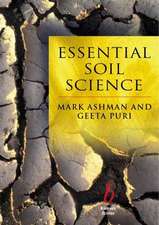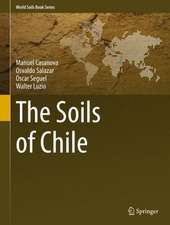Soil, Fertilizer, and Plant Silicon Research in Japan
Autor Jian Feng Ma, Eiichi Takahashien Limba Engleză Hardback – 8 aug 2002
Preț: 941.46 lei
Preț vechi: 1289.67 lei
-27% Nou
Puncte Express: 1412
Preț estimativ în valută:
180.17€ • 195.64$ • 151.34£
180.17€ • 195.64$ • 151.34£
Carte tipărită la comandă
Livrare economică 22 aprilie-06 mai
Preluare comenzi: 021 569.72.76
Specificații
ISBN-13: 9780444511669
ISBN-10: 0444511660
Pagini: 294
Dimensiuni: 156 x 234 x 17 mm
Greutate: 0.71 kg
Editura: ELSEVIER SCIENCE
ISBN-10: 0444511660
Pagini: 294
Dimensiuni: 156 x 234 x 17 mm
Greutate: 0.71 kg
Editura: ELSEVIER SCIENCE
Cuprins
1. Brief history of silicon research in Japan. 2. Silicon sources for agriculture. Silicon supply for paddy rice from natural sources. Irrigation water. Soils. Silicon supply from organic and inorganic fertilizers. Compost. Application rate in the past and the present. Short-term availability of Si in rice straw for rice plants. Long-term availability of Si in compost for rice plants. Rice husk. Silicate fertilizers. Calcium silicate slags. Fused magnesium phosphate. Potassium silicate fertilizer. Porous hydrate calcium silicates. Silica gel. Estimation of available silicon in silicate fertilizers. 3. Silicon in soil. Behavior of silicon in paddy soil. Estimating the silicon-supplying capacity of paddy soils. Measuring acetate-buffer soluble silicon (Acetate buffer method). Measuring silicon dissolved under submerged condition (Incubation method). Measuring silicon in supernatant (Supernatant method). Measuring easily soluble silicon (Easily soluble Si method). Measuring silicon dissolved in surface water (Surface water dissolution method). Measuring Si dissolved in phosphate buffer (Phosphate buffer method). Environmental factors controlling the availability of silicon for rice plants in paddy soils. Balance sheet of silicon in paddy soil-past and present. 4. Effect of silicate fertilizer application on paddy rice. Criteria for predicating silicate fertilizer requirement for paddy rice. Field experiments on the effects of silicate fertilizer application. Slag-calcium silicate. Porous hydrate calcium silicate. Silica gel and potassium silicate. Effect of calcium in slags on silicon uptake by rice. 5. Silicon-accumulating plants in the plant kingdom. Criteria for discriminating Si-accumulating plants from non-accumulating plants. Characteristics of silicon accumulators and their distribution in plant kingdom. Variety difference in silicon content in the Si-accumulating and intermediate-type species. 6. Silicon uptake and accumulation in plants. Three modes of uptake for silicon. Characteristics of Si uptake by rice. High capacity for Si uptake. Uptake form of Si. Kinetics of Si uptake. Effect of transpiration on Si uptake. Effect of nutrient salts on Si uptake. Participation of metabolism in Si uptake. Effects of metabolic inhibitors on Si uptake. Effect of glucose and organic acids on Si uptake. Effects of light on Si uptake. Roles of root hairs and lateral roots in silicon uptake. Genotypical difference in silicon uptake. A rice mutant defective in silicon uptake. Similarity mode of uptake for silicon and germanium. Effect of Ge on the growth. Similarity in uptake between Si and Ge. Chemical form and accumulation process of silicon in rice. 7. Functions of silicon in plant growth. Beneficial effects of silicon on plant growth. Rice. Deficiency symptoms. Effect of time of Si supply on the growth of grain yield. Effect of Si supply levels on the growth and grain yield. Effect of Si on the growth of various rice cultivars. Effect of Si on nutrient uptake. Barley. Tomato. Cucumber. Soybean. Strawberry. Bamboos. Scouring rush and horsetail. Functions of silicon. Stimulation of photosynthesis and translocation of photoassimilated CO2. Photosynthesis. Effect of Si on the translocation of photoassimilated CO2 to panicle. Alleviation of physical stress. Radiation injury. Water stress. Climatic stress. Improvement of resistance to chemical stress. Nutrient-imbalance stress. Excessive N stress. Deficiency of P and excess stress. Metal toxicity. Excess Na. Fe toxicity. Mn toxicity. Al toxicity. Increase of resistance to biotic stress. Disease. Pest. Working process of beneficial effects of silicon on plant growth. 8. Summary and prospect of silicon research. Major achievements and prospect of the research on silicon in soil. Survey on Si fertility. Method for evaluation of available Si in paddy soil. Major achievements and prospect of research on silicon fertilizer. Utilization of slag as a silicate fertilizer. Development of new silicate fertilizers. Evaluation of rice straw as a Si source. Major achievements and prospect of research on silicon in plants. Distribution of Si-accumulator in plant kingdom. Form of silicon taken up by rice plants and the mechanism of uptake. Form and distribution of silicon in the plant. Beneficial effects of Si on crop growth. 9. Silicon research in the world. Effect of silicon on crop production. Rice. Upland rice. Sugarcane. Horticultural crops. Role of silicon in disease and pest control. Alleviative effect of silicon on abiotic stresses. Appendix. Appendix 1. SiO2 concentration of 380 river waters. Appendix 2. Survey on SiO2 contents in flag leaf of rice plants. Appendix 3. Content of Si and Ca in Angiospermae, Gymnospermae, Pteridophyta and Bryophyta. Content of Si and Ca in Pteridophyta. Content of Si and Ca in Oryzeae. Content of Si and Ca in Bambusoideae, Pooideae, Panicoideae, Ergrostoideae. Content of Si and Ca in Commelinaceae. Content of Si and Ca in Juncaceae. Content of Si and Ca in Cucurbitaceae. Content of Si and Ca in Urticaceae. Si accumulation in 4 sub-families of Gramineae. Distribution of Si accumulator in Pteridophyta. Water-soluble SiO2 content in the soils. Appendix 4. Si content of barley grain. Standard variety. Barley core collection of United State. Barley core collection of East Asia. References. Index.









